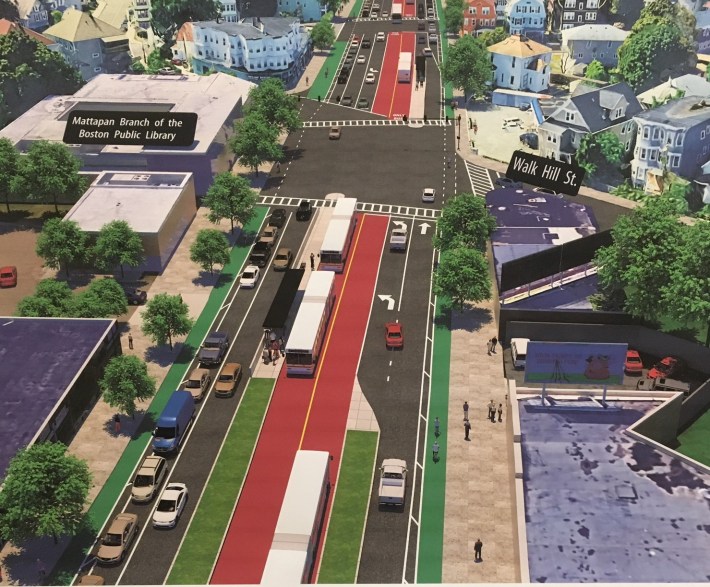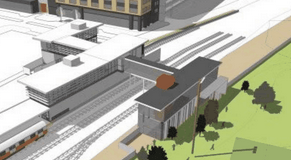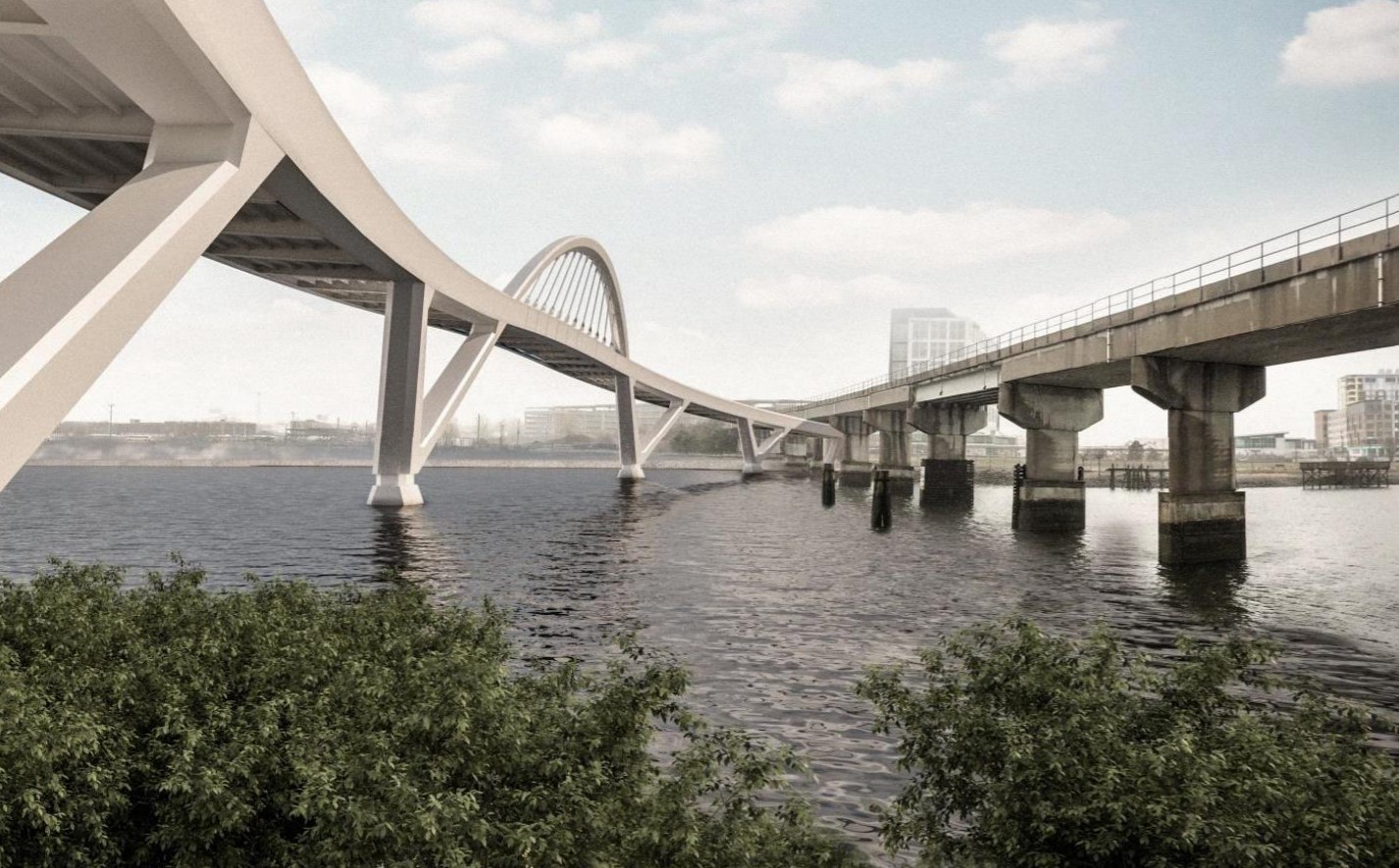In addition to a dramatic reconfiguration of the Lynnway, which we reported on yesterday, Massachusetts agencies also submitted federal grant applications this week for the proposed Mystic River bike and pedestrian bridge that would link Everett to the Assembly Orange Line station, for center-running bus rapid transit on Blue Hill Avenue, and for security fencing along the Knowledge Corridor rail line in the Pioneer Valley.
Those are the Commonwealth's entries for this year's round of federal RAISE grants. RAISE, formerly known as BUILD and TIGER, is a competitive discretionary grant program that, according the Biden administration, “will prioritize projects that can demonstrate improvements to racial equity, reduce impacts of climate change, and create good-paying jobs.”
This year's round of grants will allocate $1 billion among the 50 states, with a maximum grant award of $25 million.
Here are more details on the Commonwealth's grant applications:
Blue Hill Ave. Bus and Bike Lanes
The City of Boston has submitted a RAISE grant application to finish community outreach, final design, and construction of a center-running busway and protected bike lanes on Blue Hill Ave. from Grove Hall to Mattapan Square.
"The application stressed that we will be having a center-running bus lane in that corridor, and that in the coming year we’ll be designing the specifics around that design concept," said Vineet Gupta, the Boston Transportation Department's Director of Planning, in a phone conversation with StreetsblogMASS on Wednesday.
"We also want to make sure it’s pedestrian friendly, that traffic moves effectively, and that people on bikes have access as well. And we’re working hand in hand with the community so that they feel pride and ownership over the design. We’re gearing up to do some more grassroots community outreach, and that process will take about a year," Gupta added.

The current concept (rendering above) was revealed in a public open house at the Perkins Community Center in Dorchester on March 5, 2020. At that time, the City of Boston had hoped to continue outreach and finish design over the course of the summer, and potentially begin construction in 2021.
But that meeting ended up being the last public meeting StreetsblogMASS covered in person; as with many other projects, the pandemic forced the city to put its outreach efforts on hold, and find new ways of engaging with the public.
Last year, the city and the MBTA filed a similar application for Blue Hill Avenue through the same discretionary funding program. But the Trump administration rejected it, opting to fund a $300 million highway interchange in Hopkinton instead.
But the project might have a more sympathetic audience in the Biden administration, which has expressed strong interest in investing in projects that improve racial equity and reduce greenhouse gas emissions.
According to the 2020 grant application, a center-running busway on Blue Hill Avenue would benefit roughly 20,000 bus riders in Dorchester and Mattapan, reduce their collective commuting times by 800 hours every day, and, with less time wasted in traffic, allow the T to make over 100 additional daily trips on existing routes using the same number of buses and drivers.
Furthermore, most of those benefits would accrue to historically underserved communities in Dorchester and Mattapan. Because the vast majority of the route’s neighbors identify as people of color, the project could also make large strides in addressing structural inequities in the MBTA’s bus network, where black bus riders spent, on average, 64 more hours every year traveling than white bus riders before the pandemic.
Gupta said that Boston is seeking $25 million in federal funds for the project (the maximum possible value of a RAISE grant). The city would match that funding with $8.3 million from the City of Boston and $6.2 million from the MBTA.
Mystic River Bike and Pedestrian Bridge
MassDOT also submitted a grant application seeking $25 million in federal funds for the planned Mystic River bike and pedestrian bridge, which would extend the Northern Strand Trail from Everett to the Assembly Orange Line Station.
The bridge (pictured in a rendering at the top of this article) is almost fully designed and has already gone through key environmental reviews. But for the past two years, it's been stalled for want of two things: a financing plan, and cooperation from the MBTA to build a new Assembly station entrance on the eastern side of the Orange Line tracks, facing the Mystic River.
The current Assembly station's entrances are all located on the west side of the MBTA tracks, facing the Assembly Row development. Without a new station entrance, pedestrians using the new bridge would have to walk an extra quarter-mile north to the nearest existing track crossing, then double back and walk another quarter-mile to the current station entrance.

This year's RAISE grant application aims to solve both those problems by funding the bridge itself plus a brand-new headhouse for the Assembly Orange Line station on the riverfront side of the Orange Line tracks, facing Draw Seven Park (shown in a rendering at right). This new station entrance would allow a direct point of access between the new bridge and the subway platforms.
An analysis in 2018 estimated that the new bridge would attract over 2,000 users every weekday, and more on weekends.
If it wins grant funding, MassDOT would spend the next year finalizing design and securing permits, begin construction in early 2023, and potentially open the new bridge before the end of 2024.
Read MassDOT's grant application for the Mystic River Bike and Pedestrian Bridge.
Surveillance Equipment on the Knowledge Corridor
Unlike the others, MassDOT's third RAISE grant application is less focused on improving transit service, and more focused on policing its rail corridor through the Pioneer Valley.
The agency is asking for $18 million for "the construction and installation of various safety and security measures, including security fencing to minimize trespassing, Blue Light Emergency Call Box Stations and CCTV cameras at stations, expanded Amtrak police radio coverage, buried fiber optic cable throughout the corridor, innovative surveillance equipment such as an aerial drone and Polaris Ranger Utility Task Vehicle, and T-20 hand-thrown switch machines along the line," according to a MassDOT press release.
Ben Heckscher, co-founder of Trains In the Valley, a Pioneer Valley organization for passenger rail advocates, expressed some concerns about the proposal in an email to StreetsblogMASS on Thursday.
"The MassDOT-owned rail corridor north of Springfield bisects parts of Springfield, Holyoke and Northampton, and there are some people in these cities who think nothing of walking across the tracks to get to the other side. This is clearly a problem," Heckscher acknowledged.
But Heckscher hadn't heard anything about the proposal until MassDOT announced their grant application this week, and he expressed some doubts about how well it would be received among the rail line's neighbors.
StreetsblogMASS has requested a copy of the grant application for additional details, but so far hasn't yet received a copy of the document.






